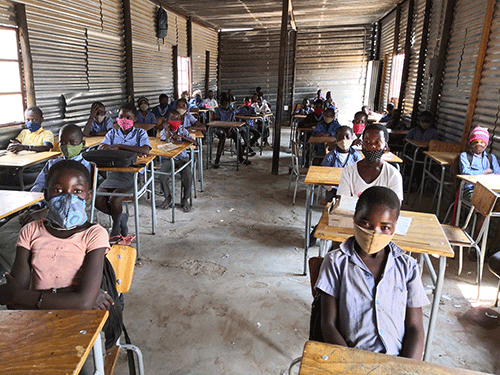OTJEKUA- Children of the marginalised Otjekua village in Omusati have dreams of becoming professionals and escape their community’s cycle of poverty but an array of challenges hamstring their development.
The school at the village, catering for learners from grades 0 to 8, does not have proper facilities for a conducive environment, often runs out of water and is unable to attract qualified teachers.
Instead of being in school, boys are left to herd cattle, while the girls become victims of child marriage and pregnancy.
To rub salt in the wound, many children at Otjekua do not get placement in high schools in their native Omusati and are forced to look for placement in other regions.
Villagers narrated that their children are forced to look for schools in other regions and because of the absence of supervision in rented accommodations, end up falling pregnant.
Some drop out of school because their parents cannot afford to send them to other regions.
The Otjekua Combined School is situated 13km west of Otjorute between Ruacana and Omakange.
The parents said there are graduates from the village. The situation is a thorn in the flesh because they also want to see their children excel.
“People want these things hidden, but our children are victims of child marriages and early pregnancy and more painful is to see children who qualify to go to secondary school remaining in the village,” said the parent who chose to remain anonymous.
According to the ministry of gender’s report on child marriages published last year, the prevalence of child marriages among girls in Namibia is 18.4% while that of boys is considerably lower than 4.1%.
By the region, the highest prevalence rate of child marriage is observed in Kavango at 39.7% while Kunene reported 24% and Zambezi 23.3%.
The principal at Otjekua Combined School, Teofilus Mbalundu, confirmed the sentiments of the parents.
Mbalundu said the learner dropout at the school is very high, especially during the rainy season as the learners leave for the cattle post to look after livestock.
“The children only return later to show that they are still interested in school because their social grant forms need to be signed by the school,” said Mbalundu.
At present, the school only has 224 pupils.
He said the number is also only high when the learners are being provided with food during the school feeding programme.
The principal said the school has not received food this year.
A male learner at the school said he misses out on schoolwork because he has to herd cattle.
“There are weeks I don’t come. Some days I arrive late because I have to look for livestock in the morning, but this is not what I want I want to attend school full-time,” he said.
Other learners complained of the long distance they trek to school.
The school caters for surrounding villagers and some learners trek about 30km to and from school.
“Sometimes when I see that it is very hot, I walk back home because then I know I am extremely late,” said one learner.
The female learners also lamented how they miss school because they do not have sanitary pads.
“We borrow pads from each other, but if we all don’t have, then we opt to stay home,” said a female learner.
They said because their parents are unemployed, it is difficult to get money to buy sanitary pads.
To compound the challenges, the principal said the school struggles to get qualified teachers.
He said some teachers are now enrolled with the in-service training programme run by the ministry.
A teacher at the school, Saviour Kalonda complains that the school has dilapidated classrooms.
“About 60 learners are taught in a corrugated iron shack, exposed to cold weather during winter and extreme heat during summer,” he said.
Kalonda said the school is also in need of modern toilets as there are currently only two pit latrines for both learners and teachers.
At the same time, he said, the school also needs extra water provision because it sometimes runs out of water because all the surrounding villages share the existing borehole.
The school was recently sponsored with a computer by Netagea Investment to print teaching materials for the learners.
Previously, printing was done at the circuit office and nearby schools. An effort by New Era to enquire what the ministry of education in Omusati is doing to improve teaching and learning at the school failed.
We could not get hold of Benny Eiseb, the regional director.
His phone was not answered, and did not respond to questions sent to him.


